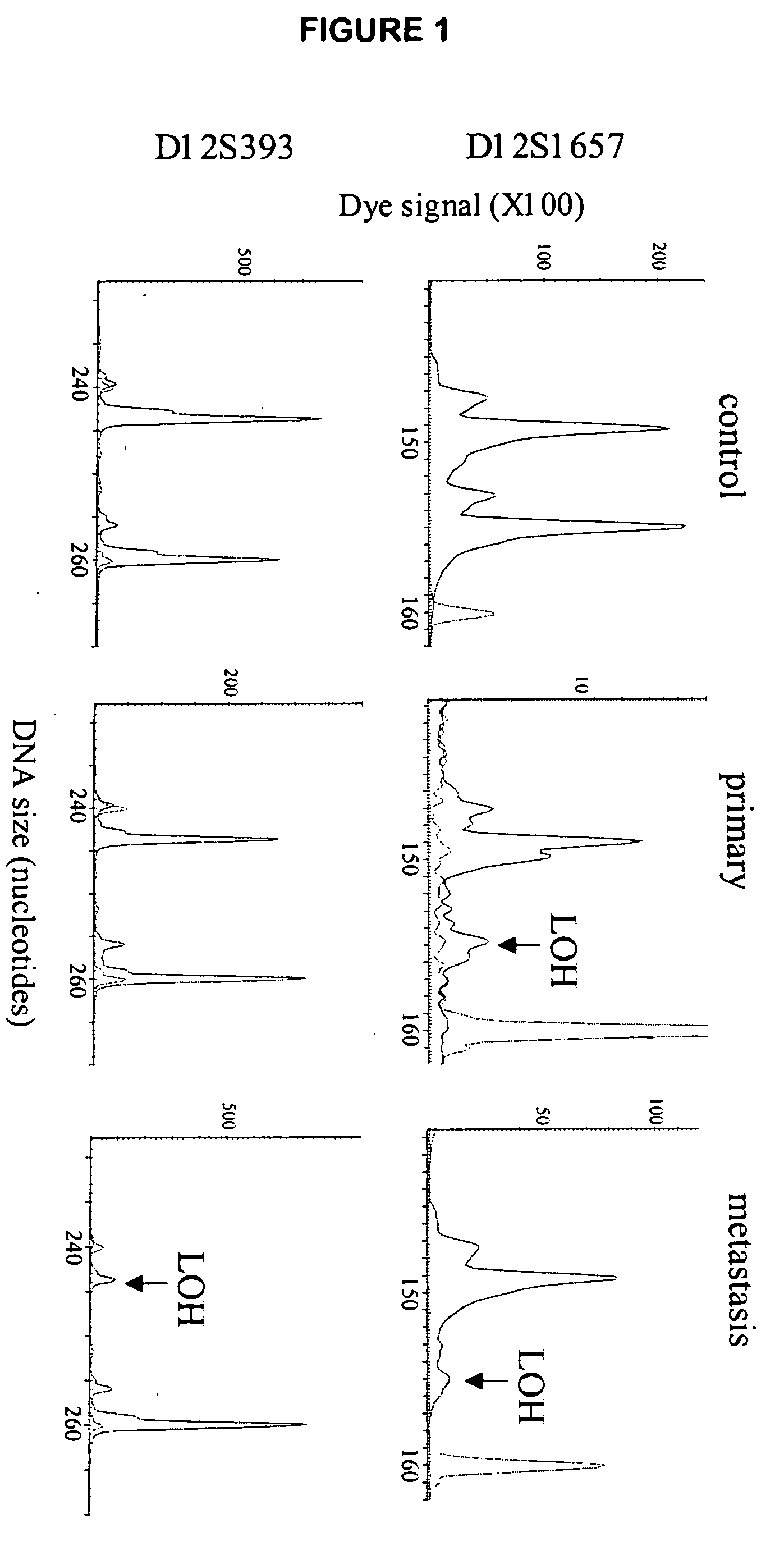Loss of heterozygosity of the DNA markers in the 12q22-23 region
a dna marker and loss of heterozygosity technology, applied in the field of molecular biology and oncology, can solve problems such as difficulty in predicting patient response, and achieve the effects of poor therapy effect, high probability, and high probability
- Summary
- Abstract
- Description
- Claims
- Application Information
AI Technical Summary
Benefits of technology
Problems solved by technology
Method used
Image
Examples
example 1
Allelic Imbalance of 12q22-23 Associated with APAF-1 Locus Correlates with Poor Disease Outcome in Cutaneous Melanoma
Methods and Materials
[0057] Tumor DNA collection and preparation. Primary (n=62) and metastatic melanoma (n=112) were collected from 164 patients including 10 cases which we collected paired primary and metastatic tumors. Institutional Review Board approval and histopathologic confirmation from Saint John's Health Center and John Wayne Cancer Institute joint committee were obtained prior to study initiation. Tumor tissues were reviewed by the pathologist to confirm histopathologic status. Melanoma tissue sections were cut at 5 μm thickness and stained with hematoxylin for microdissection. Tumor cells were collected using the PixCell II Laser Capture Microdissection (LCM) System (Arcturus Engineering, Mountain View, Calif.) as previously described (Hoon et al., 2002, Methods Enzymol. 356:302-309). Captured cells were digested with proteinase K at 50° C. overnight, f...
example 2
Allelic Imbalance on 12q22-23 in Serum DNA of Melanoma Patients Predicts Disease Outcome
Materials and Methods
[0080] Serum DNA collection and preparation. Forty-nine AJCC stage IV melanoma patients treated with concurrent BC regimen of dacarbazine (DTIC), cisplatin, vinblastin, interferon α-2b, IL-2, and tamoxifen as previously reported (O'Day et al., 1999, J. Clin. Oncol. 17:2752-2761; and O'Day et al., 2002, Clin. Cancer Res. 8:2775-2781) were selected (Table 4).
TABLE 4Clinical characteristics of BC patients# AI / # informative casesCharacteristicsnpre-BC serumpost-BC serumTotal patients4916 / 44 (36%)16 / 44 (36%)Sexmale3814 / 35 (40%)13 / 35 (37%)female11 2 / 9 (22%) 3 / 9 (33%)Age (median 45) 3312 / 30 (40%)10 / 30 (33%) ≧5016 4 / 14 (29%) 6 / 14 (43%)BC responseResponderCR13 1 / 12 (8%) 4 / 12 (33%)PR10 3 / 9 (33%) 4 / 9 (44%)SD3 1 / 3 (33%) 1 / 3 (33%)Non-responderPD2311 / 20 (55%) 7 / 20 (35%)LDH≦19022 7 / 19 (37%) 6 / 19 (32%) >19027 9 / 25 (36%)10 / 25 (40%)# of metastasis sites ≦22810 / 25 (40%) 7 / 25 (28%) >221 6...
PUM
| Property | Measurement | Unit |
|---|---|---|
| thickness | aaaaa | aaaaa |
| thick | aaaaa | aaaaa |
| genetic heterogeneity | aaaaa | aaaaa |
Abstract
Description
Claims
Application Information
 Login to View More
Login to View More - R&D
- Intellectual Property
- Life Sciences
- Materials
- Tech Scout
- Unparalleled Data Quality
- Higher Quality Content
- 60% Fewer Hallucinations
Browse by: Latest US Patents, China's latest patents, Technical Efficacy Thesaurus, Application Domain, Technology Topic, Popular Technical Reports.
© 2025 PatSnap. All rights reserved.Legal|Privacy policy|Modern Slavery Act Transparency Statement|Sitemap|About US| Contact US: help@patsnap.com



